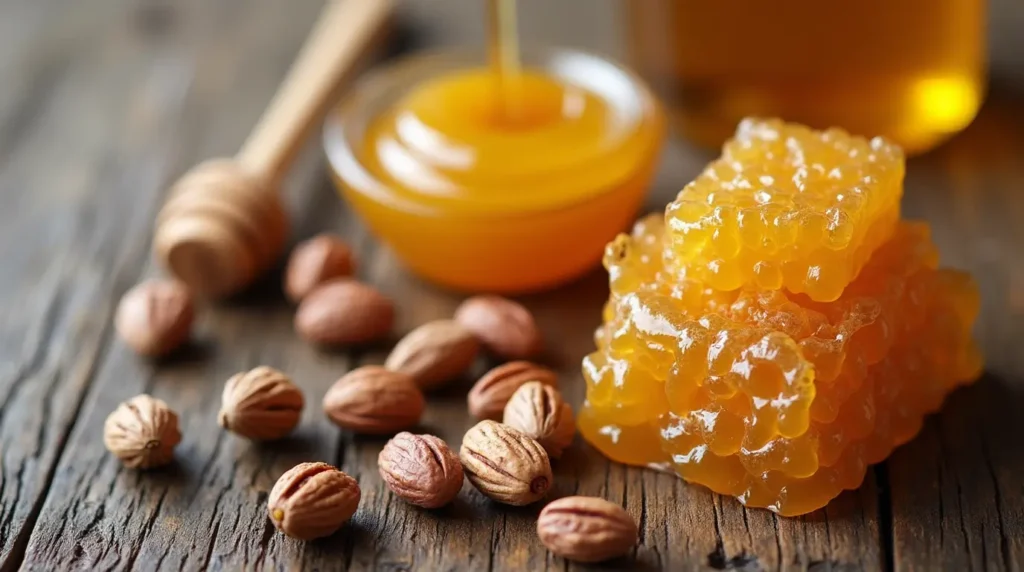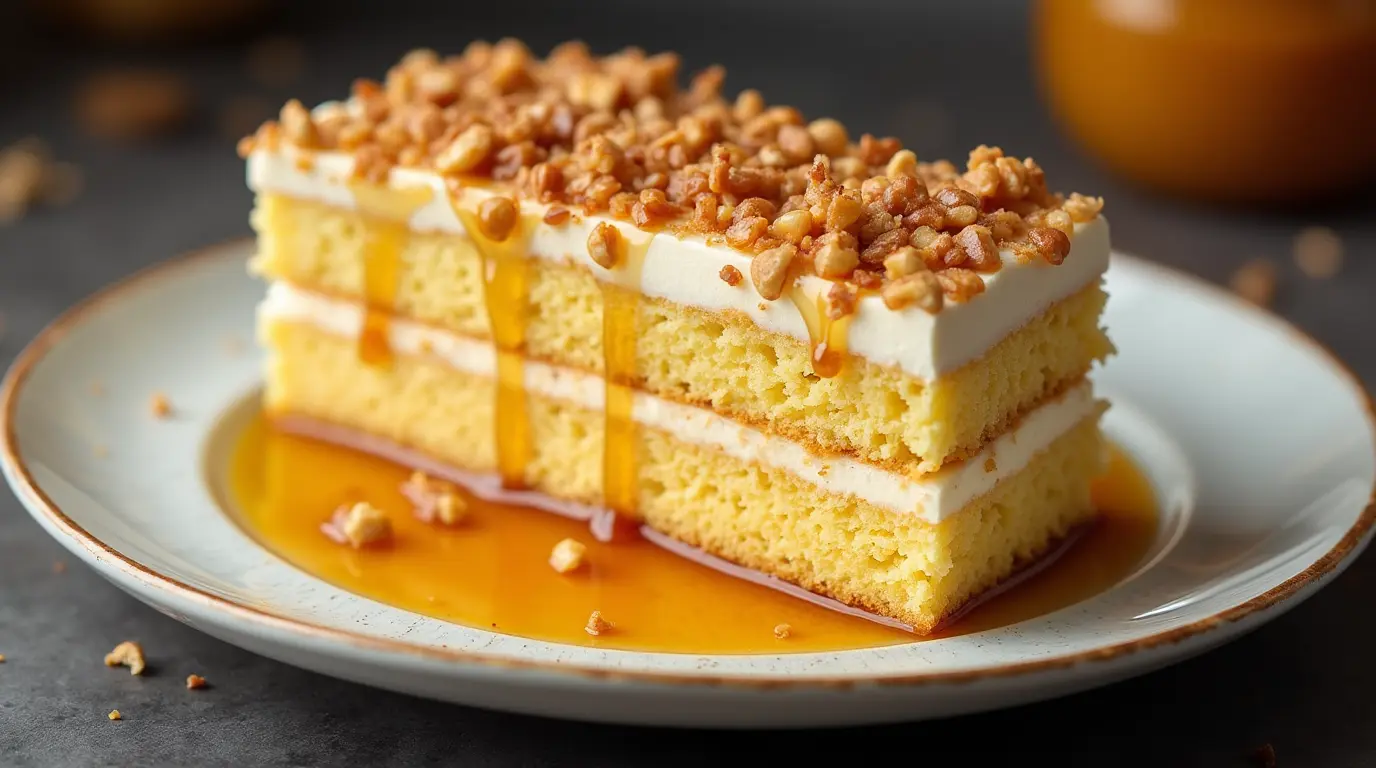Ever wondered what makes Sweethoney desserts so addictive?
From silky tofu pudding to chewy grass jelly layers, these treats are all about contrast, soft and crunchy, warm and cold, creamy and sweet. Here’s what sets them apart, and how to recreate the magic at home.
Table of contents
What is Sweethoney Dessert?
Sweethoney desserts refer to any sweet treat where honey plays a starring role. From sticky honey cakes to syrup-drizzled baklava, these desserts have a distinct richness and depth of flavor that sugar alone simply can’t replicate. Honey brings more than just sweetness; it adds complexity, warmth, and even a touch of nostalgia to every bite.
Did you know? Honey has been used as a natural sweetener for over 8,000 years. It’s one of the earliest recorded ingredients in desserts, predating refined sugar by millennia.
A Brief History of Sweethoney Desserts
The roots of sweethoney desserts stretch across ancient civilizations. The Greeks combined honey with nuts to create early versions of baklava, while Egyptians used it in sweetened bread and cakes. Medieval Europe also saw honey used widely in desserts before sugar became mainstream.
Fast forward to today, and honey is experiencing a resurgence. As more people look for natural and organic ingredients, honey has become a favored choice for home bakers and professional chefs alike.
Why Are Sweethoney Desserts So Popular?
There are plenty of reasons why sweethoney desserts remain a crowd favorite. Honey’s versatility is unmatched it pairs beautifully with fruits, nuts, and spices. Plus, it’s healthier than many other sweeteners, providing trace nutrients and antioxidants. Add to that its unique flavor profile, and it’s easy to see why these desserts are so beloved.
Curious about what makes a dessert feel luxurious? Discover the full profile of a rich dessert, flavor, texture, and experience.
Common Ingredients in Sweethoney Desserts

The Role of Honey in Desserts
Honey isn’t just an ingredient it’s the star of the show. Its viscosity makes it an excellent binder for baked goods, while its caramel-like flavor deepens during cooking. Depending on the type of honey used wildflower, clover, or manuka you can achieve slightly different flavors in your dessert.
Other Key Ingredients that Enhance Flavor
While honey takes the spotlight, other ingredients play supporting roles. Nuts like almonds, pistachios, and walnuts add crunch and richness. Citrus zest and spices like cinnamon or cardamom enhance the honey’s natural flavor. Dairy products, including cream and butter, bring balance and creaminess.
Organic vs. Processed Honey: Which is Better?
When it comes to making sweethoney desserts, the quality of your honey matters. Organic, raw honey is often preferred because it retains its natural enzymes, antioxidants, and floral notes. Processed honey, on the other hand, is often stripped of its unique properties through pasteurization. If you’re aiming for authenticity and health benefits, go organic.
“Using raw honey is like painting with a full palette of colors, while processed honey is a diluted version of its true potential.”
Top Varieties of Sweethoney Desserts
Cakes and Pastries with Honey
From honey-drizzled chiffon cakes to layered honey cakes like the Russian Medovik, these desserts showcase honey’s ability to add moisture and depth. Cakes infused with honey tend to stay soft and flavorful for longer, making them perfect for celebrations.
Traditional Honey-Based Treats Around the World
Many cultures have iconic honey desserts. Middle Eastern baklava, Indian gulab jamun soaked in honey syrup, and Greek loukoumades are just a few examples of how honey transcends borders. These traditional recipes have stood the test of time, offering flavors that are as comforting as they are unique.
Modern Takes on Classic Honey Desserts
Today’s chefs are reinventing sweethoney desserts with contemporary twists. Think honey panna cotta with lavender, honey ice cream swirled with salted caramel, or even honey-infused macarons. These modern adaptations keep the tradition alive while appealing to adventurous palates
The Health Benefits of Sweethoney Desserts
Nutritional Benefits of Honey
Honey isn’t just a sweet treat it’s packed with health benefits, making sweethoney desserts a more wholesome choice. Unlike refined sugar, honey contains trace vitamins, minerals, and antioxidants. It’s a natural energy booster, thanks to its simple sugars (glucose and fructose) that are easily digested by the body.
Additionally, honey has antimicrobial properties, which can be beneficial for soothing sore throats or aiding in digestion. Using honey as a dessert ingredient allows you to enjoy something indulgent without feeling guilty.
Balancing Sweetness and Health in Desserts
While honey-based desserts can be healthier, balance is key. Too much honey can make a dessert overly sweet or sticky. By pairing honey with nutrient-dense ingredients like whole grains, nuts, and fruits, you can create treats that are both satisfying and nourishing.
Want protein-rich treats with natural sweetness? Try our cottage cheese desserts, indulgent, creamy, and surprisingly nutritious.
For instance, a honey and almond granola bar makes for a great midday snack, providing natural energy without the sugar crash. Sweethoney desserts don’t have to be heavy they can be light, flavorful, and packed with good-for-you ingredients.
“Desserts don’t have to be a guilty pleasure. With honey, they can be a delicious way to nourish both the body and soul.”
Common Myths About Honey and Sugar
One common misconception is that honey and sugar are nutritionally the same. While both are sweeteners, honey has a much lower glycemic index than sugar, meaning it won’t spike your blood sugar as quickly. It’s also less processed, making it a more natural choice.
Another myth is that cooking with honey destroys its nutrients. While high heat does reduce some of its beneficial properties, many desserts are baked at temperatures that preserve much of honey’s goodness.
DIY Sweethoney Dessert Recipes
Easy Recipes for Beginners
You don’t have to be a master baker to create delicious sweethoney desserts. Here are a couple of simple recipes to get you started:
Honey Yogurt Parfait
- Ingredients: Greek yogurt, honey, granola, fresh berries.
- Instructions: Layer yogurt, honey, and granola in a glass, topping with fresh berries for a healthy and satisfying treat.
No-Bake Honey Oat Bars
- Ingredients: Rolled oats, peanut butter, honey, chocolate chips.
- Instructions: Mix all ingredients, press into a pan, and chill until firm. Slice into bars and enjoy!
These recipes are perfect for beginners looking for quick and satisfying ways to enjoy honey-based treats.
Advanced Techniques for Gourmet Desserts
For those ready to step up their game, sweethoney desserts can be elevated to gourmet levels. Consider trying a layered honey mille-feuille, where flaky puff pastry is paired with honey-infused cream. Another option is a honey brûlée, which combines honey’s sweetness with the crunch of caramelized sugar.
Advanced techniques often involve balancing textures and flavors. For example, pairing creamy honey panna cotta with a tart fruit compote creates a dessert that’s both indulgent and refreshing.
Troubleshooting Common Issues in Honey-Based Recipes
Even the best bakers encounter challenges when working with honey. Here are some common problems and solutions:
- Problem: Desserts turn out overly sticky.
- Solution: Use the correct amount of honey and avoid overmixing.
- Problem: Honey flavor is too mild or overpowering.
- Solution: Choose the right type of honey. Darker honey has a stronger flavor, while lighter honey is more subtle.
- Problem: Desserts don’t set properly.
- Solution: Adjust baking times and ensure other ingredients, like eggs or gelatin, are balanced correctly.
Short on time? Browse our quick & easy recipes for effortless sweet creations with maximum flavor.
Frequently Asked Questions (FAQs)
Are Sweethoney desserts served hot or cold?
Both! Many Sweethoney-style desserts are served warm (like tofu pudding), while others are chilled or iced, offering contrast in texture and temperature.
Can I make Sweethoney-style desserts at home without specialty ingredients?
Yes, you can recreate similar textures using agar-agar, coconut milk, fresh fruit, and glutinous rice flour available in most Asian supermarkets.
What makes the texture of Sweethoney desserts so unique?
It’s the combination of soft puddings, chewy jellies, tapioca pearls, and fresh fruits. Layering and contrast are key to the experience.
Are these desserts dairy-free?
Many are! Traditional versions often use coconut milk or soy milk instead of dairy, making them suitable for lactose-intolerant or dairy-free diets.

